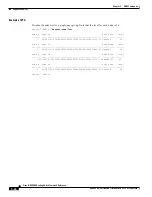
5-82
Cisco MGX 8850 Routing Switch Command Reference
Release 2.0, Part Number 78-10467-04 Rev C0, October 2001
Chapter 5
PNNI Commands
dsppnni-node-list
Display Contents for the dsppnni-node-list Command
This section describes the contents of a node list. For a multi-peer group (not applicable in the current
release), it also describes how the display changes from one level of a hierarchy to a higher level.
Although the description relates primarily to the example of a multi-peer network diagram in
Figure 5-8
,
the information also substantially applies to the example SPG that follows the MPG example. The
diagram in
Figure 5-8
reflects the MPG display in the Example section.
The paragraphs that follow describe the progression in node numbers, levels, and the node index
appended to the switch name in an MPG network.Refer to
Figure 5-8
.
1.
The display shows all network nodes that are known to the lowest level. These nodes consist of all
nodes in the peer group, all nodes on the level of its parent node, all nodes on the level of its
grandparent, and so on. The MPG shown in the Example section illustrates this concept.
The numbers in the “node #” column begin with 1—which is the local node itself—then continues
with the next learned node, and so on. The node# increases by 1 with each discovered node.
2.
When the sequence re-starts with node # 1, the display has begun showing the view from the next
higher node in the hierarchy. At this next higher level, node # 1 is the current node itself, which has
made its own list of nodes. The display continues with peer group members of that level, the
members of the parent’s group, the grandparent and members of the grandparent’s group, and so on.
The MPG in the Example section illustrates this progression.
node #
The node number (node #) is a reference to the nodes in the network—not a node in
the hierarchy of an MPG on a switch (see the dsppnni-node description for details
about node index). The entity that has this view and compiles this list of node
numbers is a local logical node. The node numbers have a range of 1–256. Node #
1 is the logical node that is making its list of network nodes. In an MPG list, multiple
instances of node # 1 appear because the logical node at each level sees itself as
node # 1. Also, each node in a multi-peer group has information for nodes in its peer
group but also for all nodes on the level of its parent, grandparent, and so on. See
Figure 5-8
and the Example section.
Whether a node belongs to a single-peer group or a multi-peer group, each logical
node increments node # by 1 according to the sequence that it discovers other nodes.
The paragraphs that follow this list give more details about the node number
sequence for a multi-peer group.
You can only view a node number in applicable displays or provide it as a command
parameter. For example, you can provide a node number to the dsppnni-path
command.
node id
The node-id consists of the level, the length of the ATM address, and the ATM
address itself.
node name
The name of the switch (not the name of a logical node). The root of this node name
results from the cnfname command. If a dash number follows the node number, that
number is the node index that pertains to the hierarchy of nodes on the switch. For
this command, a number is appended only for nodes above the lowest level on the
switch.
level
The level is set through addpnni-node or cnfpnni-node. It has a range of 1–104
and a default of 56.
















































